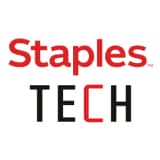USB Cables
Related Searches
Trending now
A very common connection protocol is USB or Universal Serial Bus. If you’ve ever charged or transferred data from one device to another, you’ve likely used a USB cable to do so. Staples offers a wide variety of USB cords to choose from. Keep reading to find out more about Staples’ selection of products.
What Are USB Cables?
Typically, USB cords are used to supply electrical power to devices and connect them together to transfer digital data. For example, the USB standard is often used to charge smartphones, tablets, cameras and laptops. They’re typically short in length, making them easy to store and use in home and office settings.
What Are the Benefits of USB Cords?
Because of their popularity, USB cables are incredibly versatile. They are likely to be compatible and interchangeable with many frequently used devices.
USB cords can be used to connect devices in offices, where they can boost the performance of employees by speeding up processes or allowing them to use multiple tools to increase efficiency. In users’ homes, they can be used to charge personal electronics, like portable speakers and radios.
They are also great for charging on the go, as long as users bring the right chargers and connectors. They take up very little space and are especially useful on long roadtrips or airport layovers.
What Kind of USB Cable Should You Buy?
To help determine the correct USB cable for your needs, listed below are some features to consider.
Conversion Cable Types
There are 3 main types of conversion cables used in the world of USB cords.
USB to VGA
While less common now, older monitors, laptops and TVs may have VGA, or Video Graphics Array ports to receive analog video and data. They are still in use today to help connect modern devices to older ones.
USB to HDMI
High-Definition Multimedia Interface, or HDMI, is a data transfer standard for simultaneously transmitting digital video and audio from a source like a computer or A/V receiver to a TV or other video output. This type of USB cable is essential for connecting items that don’t have HDMI ports to TVs, projectors and computer monitors throughout your office. They are also commonly used in households to connect streaming devices and gaming consoles.
USB to DVI
Send both digital and analog video signals through the USB port when it is coupled with a DVI (Digital Visual Interface) connector on the other end. The DVI standard is commonly found on computers, LCD monitors, projectors and other digital display equipment pieces due to its versatility. It allows manufacturers to support modern technology as well as older analog devices with one port.
Connector Types
Within the USB standard itself, there are multiple types of connectors with different shapes and use cases. Below are the different types.
USB-A
This is the standard connector likely to be included on most desktop PCs, older laptops, TVs, game consoles and media players. Although USB-A connectors have more internal pins, they can operate in any Type-A port.
USB-B
This less common connector is mostly used to connect printers and external hard drives to desktop computers. It has two different configurations to be aware of. One is for USB 1.1 and 2.0 speed protocols, while the other is for faster data transfer with USB 3.0.
USB-C
Many smaller devices will house USB-C ports due to its smaller and slimmer design. They’re typically found on smartphones and tablets as well as some newer laptop computers in place of the USB-A connections on older laptop designs.
USB-Mini
The Mini connection is common to portable electronics like digital cameras, MP3 players and some computer mice. It only features USB 1.1 and 2.0 speeds, while remaining capable of charging these smaller devices.
USB-Micro
Popular to many Android smartphones and external hard drives, the USB Micro standard features USB 2.0 and even 3.0 speeds. This makes retrieving media and data from hard drives a breeze.





































































































